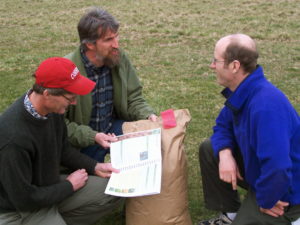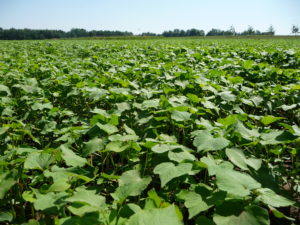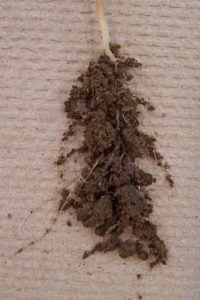All Dressed Up and No Place to Snow: Filling Soil Health Prescriptions with Targeted Cover Crops
Can you name fifteen uses for cover crops?

Thomas Björkman, Cornell University, Andy Leed, organic farmer from Candor, NY and Dan Brainard, horticulture professor at Michigan State University, consult the Cornell Soil Health Manual to identify management goals for which buckwheat is suited. Photo by Thomas Björkman
Thomas Bjorkman, an associate professor of horticulture at Cornell University, can. And he’s using this list of “management goals”—including weed reduction, erosion prevention, soil aggregate stability, increased organic matter, and disease and pest suppression—to diagnose which cover crops will most benefit farmers’ productivity levels.
Thomas’s online decision tool helps growers select among fifteen affordable, regional crops, including which management goals each addresses, where to find seeds and how to plant them, avoidable and unavoidable problems, and classic uses. Seed venues, planting dates, and even the crops themselves are tailored to New York State and its soil and climate conditions, promoting reliable procedures and locally obtainable species, which minimize cost and environmental impact.
The online tool summarizes Thomas’s research results to date. With the help of a SARE grant in professional development, he is spreading the benefits in multiple ways. Extension staff around the state are being trained to use the new Cornell Soil Health Test to help determine management goals, and to work with farmers to produce tailored recommendations for a cover crop program for their beds. In developing a cohort of farmers who have had their soil tested and are using cover crops in this precise and targeted way, Thomas hopes to put the method and the tools directly into farmers’ hands. He hopes farmer-to-farmer learning will be the method’s primary means of propagation.

The SARE project is expanding the use of cover crops in the summer. Summer is an excellent time to use cover crops, as seen in this solid three-week-old stand of buckwheat. Photo by: Thomas Björkman
The SARE project was born from previous research about buckwheat as a cover crop for the purpose of weed control. This first project established a network of farmers adopting cover crop use at various levels, and led Thomas to further investigate the effects of cover crops on soil health. Now, with 43 farmers’ soils tested, Thomas expects 24 to adopt the project’s recommendations. In some cases the crop is too expensive or labor-intensive for the particular farm, or no crop would significantly address the management goal. But for the most part, this targeted method addresses a problem that farmers already value, Thomas says. The project is demand-driven, lacking compensation or other standard recruitment techniques, but offering what farmers and extension agents want: free access to the tools and trainings.
The SARE process was an adjustment for Thomas, because coming from an academic background, he wasn’t used to outcome funding, where applicants are asked to outline expected social impact and milestones before embarking on the project. But, he notes, SARE cultivates its awardees, even when they are in the applicant phase. He attended a training session as SARE was moving to an outcome-funding model, which helped him make the shift. He has spent the funding on every aspect of the project, including research, outreach, and training—covering costs in labor, transport and supplies, and the crops and soil tests themselves.

Improving the crumbliness of the soil is important for vegetable growers, and buckwheat is very effective. These seedling roots are exuding a gluey substance (mucopolysaccharide) that sticks soil particles together to form a good crumb. Courtesy of Thomas Björkman.
This grant project was particularly well suited, he says, because all of the interests aligned: the farmers’, SARE’s, and the researcher’s. The research points to clear applications, and does not require going back to the drawing board, which can trip up the funding process. Farmers want their soils to be maximally productive, which is also the goal of the research. And the targeted use of cover crops fits into a larger set of practices, such as reduced tillage, that sustain farmland and conserve agriculture’s environmental context.
This article discusses SARE grant ENE09-110. To view the final report, visit the SARE website. For more information, contact Thomas Bjorkman at tnb1@cornell.edu.

